Recently I wrote a post about my first experience playing a tournament abroad, back in 1978 in Russia. Coincidentally, I got together last weekend with some chess-playing friends, and tournaments abroad were one of our big topics of conversation.
Mike Arne, a Life Master who has played almost no competitive chess since 1999, has recently retired from his job and returned to the tournament scene in a big way this summer. He went to Europe and played in both the Benasque and Biel tournaments.
Here I would ordinarily tell you what his score was over the chessboard, but what really impressed me was not his wins and losses but how much fun he had, and how much he enjoyed telling us about it. Mike is a very gregarious “people person,” and for him the biggest treat was meeting chess players from other countries and joining the worldwide community of chess. He talked about how cool it was to go to a restaurant and see the big-name chess players socializing with the “ordinary” folks.
Most of all, Mike commented on the difference between the chess culture in the U.S. and in Spain and Switzerland. The players in Europe are treated with respect. One of the arbiters in Spain called him “Maestro” and said that it was an honor to watch him play. The schedule of the tournament likewise respects the players and gives them a chance to play well. Instead of squeezing five or six games into one weekend, they play only one round a day for 9 days, so even a 65-year-old guy like Mike doesn’t get tired.
The game that Mike most wanted to show us was a loss against one of the top grandmasters in Spain, Elizbar Ubilava. I think it’s a fascinating game because it’s almost devoid of tactics. A computer won’t help you understand a game like this or play a game like this. It’s 45 moves of strategy followed by 7 moves of tactics, at the end of which the grandmaster has a won game. But until that tactical flurry at the end, Mike more than held his own, as you’ll see.
Mike Arne – Elizbar Ubilava
1. d4 Nf6 2. c4 d6 3. Nc3 e5 4. de de 5. Qxd8+ Kxd8 6. Bg5 c6 7. Nf3 Nbd7 8. e3 Bb4 9. O-O-O?! …
Mike consents to the doubling of the c-pawns. This appears to be a TN, as all the previous games I saw in ChessBase had 9. Rc1. But White’s game turns out to be surprisingly playable.
9. … Bxc3+ 10. bc Kc7 11. Nd2 a5 12. Be2 a4
A far-sighted move by the GM. Not only is he gaining space and keeping White’s knight from moving to b3, he is also planning to put his knight on c5 and lift a rook to a5 to defend that knight.
13. e4 Nc5 14. f3 … Time for a diagram.
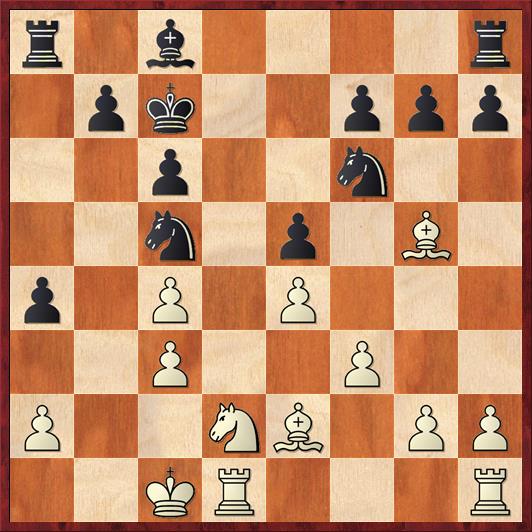 Position after 14. f3. Black to move.
Position after 14. f3. Black to move.
FEN: r1b4r/1pk2ppp/2p2n2/2n1p1B1/p1P1P3/2P2P2/P2NB1PP/2KR3R b – – 0 14
There are lots of things to say about this position. First, Ubilava offered and continues to offer Mike many opportunities to take on f6 and double Black’s f-pawns. White is never interested in doing this because he wants to keep the advantage of the two bishops, and he does not want to be stuck in a position where he has a bad bishop and absolutely no dynamic possibilities. One of the big strategic themes in this game will be the battle between the two bishops and the two knights, and the struggle by each side to obtain a position that is better for his minor pieces.
Second, I believe that this is the point where Black starts going wrong. Up to here, I think that Black definitely has a more comfortable position. Somehow, over the next 15 moves, the position changes to one where White is in complete control. Black must have made a mistake — and yet there is not a single move you can point to and say, “This is a mistake.” Instead of annotating moves we have to annotate ideas.
I believe that the correct idea for Black in this position is to try to win White’s front c-pawn, because Black can attack it three times and White can only defend it twice. This is a common theme in, for example, the Saemisch Variation of the Nimzo-Indian. I would start here with first 14. … Ne6. This is useful already; it puts the question to the bishop. Are you going to e3 or h4? If 15. Bh4, then I think Black has a good opportunity to shift his attention to the kingside with 15. … Nf4, which I think forces the retreat 16. Bf1. White’s pieces are looking very disorganized. On the other hand, if 14. … Ne6 15. Be3, then I think Black’s plan is (in some order) … b6, … Ba6, … Ne8, … f6, … Nd6, … Nc5, … Nb7, … c5, … Na5. Maybe this will not be possible to execute completely, but at least the … Nf6-e8-d6 maneuver is, I think, a very good way to strengthen Black’s position.
By contrast, in the game Black’s knight has trouble finding a useful square. It ends up going from f6 to h5 to g7, where it is pathetically placed. As Jesse Kraai likes to say, “Find your worst piece and make it better.” I think it takes a certain amount of insight to realize that the knight on f6 is actually Black’s worst minor piece.
Here is how the game turned around:
14. … Be6 How could this move be a mistake, right? It completes Black’s development and puts pressure on c4. Nevertheless, Black’s pieces start to become disharmonious.
15. Nf1 Ra5?! I’ve said that there were no tactics in this game, but this was Ubilava’s one chance to tactically transform the position with a piece sacrifice: 15. … Ncxe4!? 16. fe Nxe4. It looks to me as if Black either wins two pawns, emerging with four pawns for a piece, or he wins the exchange, leading to a R+2P versus B+N situation. Curiously, Mike didn’t mention this possibility at all when we were going over the game, so I don’t know what his intention was.
As for Ubilava, I think that he was not interested in this variation because he intends to play a maneuvering game. This gives some valuable insight into grandmaster psychology. This may not be true for all grandmasters, but I think that most of them, when playing an amateur or in this case a low 2200 player, would rather turn the game into a soccer game that they win 1-0 than play a basketball game and win 101-99. There is less of a chance for things to go wrong. It doesn’t mean that Ubilava will avoid tactics, but he will go into tactics only if they lead to a clear advantage.
16. Ne3 Re8 We’re starting to see Black’s discomfort. He really wants to go … Nf6-e8-d6, but he can’t because after 16. … Ne8 White would play 17. Be7!, a super-important resource. With 16. … Re8 he protects the e7 square but now he can’t move his knight to e8. Black’s pieces are starting to fight each other: the rook and knight fighting over the e8 square, the knight and bishop fighting over e6.
17. Bh4 Nh5 18. Rhe1 g6 19. Rd2 h6 20. R1d1 g5 21. Bf2 Ng7 22. g4 f6
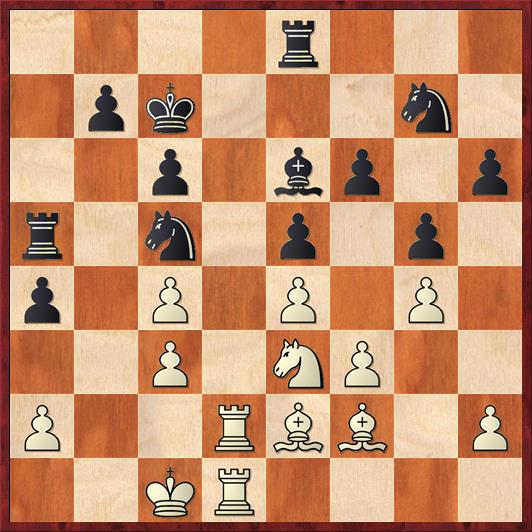 Position after 22. … f6. White to move.
Position after 22. … f6. White to move.
FEN: 4r3/1pk3n1/2p1bp1p/r1n1p1p1/p1P1P1P1/2P1NP2/P2RBB1P/2KR4 w – – 0 23
Comparing the last diagram to this one, I just have to scratch my head. How did the knight end up at g7? How did White’s rooks get doubled on the d-file? Which player is the grandmaster here? It sure looks like White.
23. Nf5! … Forcing Black to trade on f5. Which piece should he take with?
23. … Bxf5! The right decision. 23. … Nxf5 24. ed Bg8 (or c8) 25. Rd6 would be absolute torture. The text move leads to a middlegame with two knights against two bishops. This is always an interesting battle, and in many cases I would prefer to have two knights against two bishops than to have a knight and a bishop against two bishops. The reason is that the pieces have such different abilities. When you have B+N versus 2B, very often the knight is simply inferior. But when you have 2N versus 2B, the knights work together in ways that bishops can’t duplicate. It becomes a more unbalanced game, with chances for both players.
It’s fascinating to see how Ubilava makes the most of his position, essentially by contracting it. He cedes the edges of the board to Mike and consolidates his forces to the 6-by-6 square in the middle, where he hopes the battle will be fought. In close combat, the knights will be stronger than the bishops. I’ve never seen a strategy quite like this before.
24. gf … In our analysis session Mike criticized this move, but I don’t see why. It’s automatic and it’s fine.
24. … Re7 25. h4 Ne8 26. hg hg 27. Rh1 b6 28. Rh8 Nd7 29. Rd1 Nd6 30. R1h1 c5
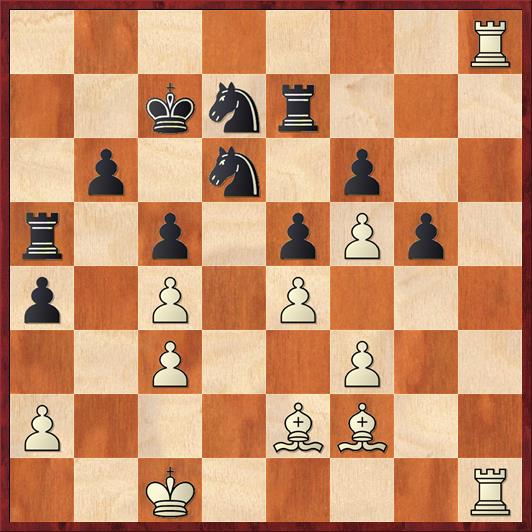 Position after 30. … c5. White to move.
Position after 30. … c5. White to move.
FEN: 7R/2knr3/1p1n1p2/r1p1pPp1/p1P1P3/2P2P2/P3BB2/2K4R w – – 0 31
Around this time Mike’s game was starting to attract a lot of attention from the other players. Here’s an unknown American who has hardly played in 20 years, with what appears to be an absolutely crushing position against one of Spain’s leading grandmasters. However, looks can be deceiving, and this position definitely is.
As Mike said in showing us the game, one thing that Ubilava did brilliantly in this game was putting his pieces where they can’t be attacked (an idea Mike attributed to Gligoric). [Correction 11/4: Mike Splane attributed it to Gligoric. See reader comments.] In particular, Black’s knight on d7 holds everything together and Mike has no way to get at it.
Also, another thing you have to ask in any position is: Where are the pawn breaks? Mike has none. So he has no way to “soften up” or create weaknesses in Black’s position. It’s far from clear how he can make progress. Mike quoted some other chess author (alas, I don’t remember who): “No pawn levers, no plan.”
But I think White does have a plan! It’s one of the most brazen plans in chess, and you can use it only in a position where your opponent has absolutely zero counterplay. I call it the Long March: moving your king from one side of the board to the other.
In this position, what I want to play as White is 31. Kg6. But I’m not allowed to do it in one move, so instead I do the Long March: Kc1-d2-e1-f2 (obviously, the bishop needs to move out of the way at some point) -g3-g4-h5-g6. Once I have gotten my king there, I can play Rh7, trade a pair of rooks, and I will then be ready to sacrifice at d7, f6, or g5. Any of these will be deadly, because the king is like an extra piece, ready to vacuum up Black’s pawns and usher the f-pawn home.
There is another terrific thing about a Long March: it saves you vast quantities of time on the clock. This game was played at the standard FIDE time control, with a 30-second increment. For eight moves you can take just five seconds a move and put a lot of time back on your clock.
The big question, of course, is whether Black is truly devoid of counterplay or whether he can short-circuit the Long March with a timely … b5. My hunch is that this move is not so terrifying for White. White simply takes on b5, puts his bishop on c4 (where it now becomes a useful attacker) and lets Black take the c3 pawn if he wants.
When I asked Mike if he had considered moving his king to g6, he looked at me in shock, and said, “I never once thought about it, during the game, or going over the game later. Not until you just asked me the question.”
What happened, as you’ll see, was that Mike kept his king on the queenside, and even made an ill-conceived feint toward the a4-pawn. When Black finally did play the break … b5, instead of being safe on the kingside Mike’s king was caught in the crossfire, and that is how he eventually lost.
31. Rg8 …
In spite of my comments above, you can’t call this a mistake. It looks awesome: doubling rooks on the eighth rank! Against a grandmaster! Mike said that he was starting to get a surge of adrenaline. “I might actually beat this guy!”
31. … Ra7 32. Bd3 Rf7 33. R1h8 Rb7!!
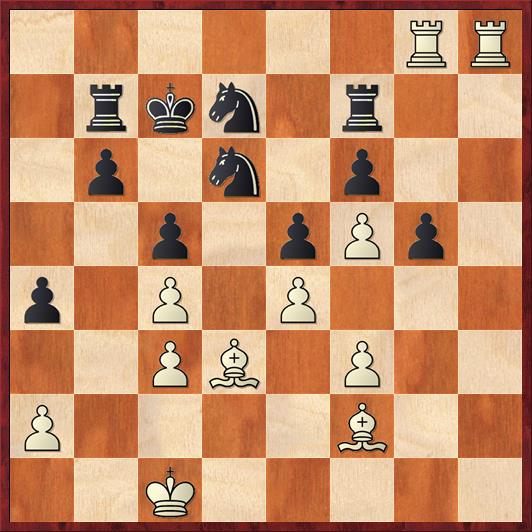 Position after 33. … Rb7. White to move.
Position after 33. … Rb7. White to move.
FEN: 6RR/1rkn1r2/1p1n1p2/2p1pPp1/p1P1P3/2PB1P2/P4B2/2K5 w – – 0 34
This is a real grandmaster move. To me, it’s the star move of the game, and the reason Ubilava was able to save his position. Ubilava tells Mike, “Go ahead and take the a-pawn. I don’t care.”
Indeed, after 34. Ra8 Rb8 35. Rxb8 Nxb8 36. Rxa4 Kb7! the rook might end up stuck on the a-file. For example, if 37. Ra3 Nc6 38. Rb3 Na5 39. Rb1 Kc6, Black can win the c4 pawn any time he wants, and Black can also take over the h-file any time he wants.
There’s another important thing that Ubilava had to see (at least, I hope he saw it). A much more dangerous idea for White is to play 34. Bc2! and go after the a-pawn with the bishop. Of course it looks as if this move hangs the c-pawn, but Black has to realize that the pawn is poisoned. After 34. Bc2! Nxc4? 35. Rc8+! White’s doubled rooks turn into savage beasts. After 35. … Kd6, 36. Bxa4 doesn’t just win the a-pawn, it threatens mate in two! Black’s most natural response is 36. … b5? (better is 36. … Rc7, but it’s still bad) and now we play the murderous 37. Rhd8! and Black can resign. The threat is 38. Bxc5 mate, and if 37. … Ke7 than 38. Re8+ also leads to mate.
Isn’t it incredible how quickly the position shifted from strategy to tactics? But that’s the way that chess works. The strategic advantage of doubled rooks on the eighth is only good if you use it for something — and in particular, rooks like this are very good at creating mating nets.
However, Ubilava surely saw all of that, and after 34. Bc2! he would not have been suckered into taking the worthless pawn on c4. Instead he would have continued the plan initiated by his previous move: 34. … Rb8! I’ve looked and looked at this, and I can’t find any advantage for White. If 35. Rxb8 Nxb8 36. Bxa4, Black imperturbably plays 36. … g4! and White’s pawn formation on the kingside starts to collapse. Alternatively, if White opts to keep rooks on and play 34. Bc2! Rb8! 35. Bxa4 right away, then 35. … Rxg8 36. Rxg8 Rh7! threatens to invade on the h-file, and White’s bishops are very poorly placed to defend.
Instead Mike moved a different piece to c2, one that was even more ineffective.
34. Kc2 Rb8! 35. Rxb8 Nxb8 36. Kb2 …
White has wasted a tempo, already a sign that he doesn’t know what to do.
36. … Rg7 37. Rh6 Nd7 38. Bg3 Rg8
See comment to move 15. Ubilava steadily avoids tactics if they are unclear. As Black, I would have been strongly tempted to play 38. … g4?, but it looks as if White is better after 39. f4! ef 40. Bxf4 Ne5 41. Bf1! Black does not want to open the position in a way that favors the bishops.
39. Ka3 Ra8 40. Rh2 Kc6
With every move, the initiative is moving back towards Black. White has made no progress against the solid granite of Black’s knights and pawns, the bishops cannot attack anything, and the king is misplaced.
41. Bf2 Ra7 42. Bg3 b5!
The tide is coming in.
43. cb Nxb5+ 44. Kb2 Rb7 45. Kc2 …
The surprising 45. Kc1, offering the c3 pawn, may have been a better try. What White desperately needs is open diagonals for his bishops, and after 45. … Nxc3 46. Be1 he’s starting to get them. But of course, Mike’s move 45. Kc2 is the one that 99 percent of us would have played, especially when we’re “playing on the increment” of 30 seconds per move. It runs into a tactical problem.
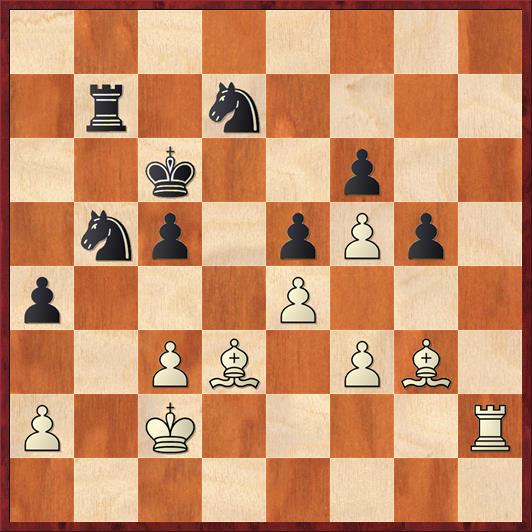 Position after 45. Kc2. Black to move.
Position after 45. Kc2. Black to move.
FEN: 8/1r1n4/2k2p2/1np1pPp1/p3P3/2PB1PB1/P1K4R/8 b – – 0 45
Remember how I said, back on move 15, that Ubilava would go for tactics only when they clearly favored him? Now is finally the time.
45. … c4!
Oof. If 46. Bxc4 Na3+ 47. Kd3 Nc5+ chases the White king away from the bishop and wins a piece.
46. Be2 Na3+ 47. Kc1 Rb1+ 48. Kd2 Rb2+ 49. Ke3 Rxa2
and Black won after a few more moves. As I recall, it did not take very long; Ubilava was able to push the a-pawn and prevent White’s rook from even coming around to the a-file to defend.
Even though Mike lost, I think it is a privilege to get a chance to play a game like this against a grandmaster. You get a chance to see how they think and how they play when their backs are against the wall.
To Ubilava’s credit, when they went over the game he did not try to pretend that his mishandling of the position from moves 14-23 was part of some brilliant, genius plan. He said to Mike simply, “You outplayed me.” How often do you hear a player who is rated 300 points above his opponent admit, “You outplayed me”?Not very often! I think that shows great sportsmanship and humility by Ubilava.



{ 2 comments… read them below or add one }
One minor correction. You wrote:
“As Mike said in showing us the game, one thing that Ubilava did brilliantly in this game was putting his pieces where they can’t be attacked (an idea Mike attributed to Gligoric). ”
Mike Arne made the first statement, but not the one in parentheses. That was my
comment/observation. A more precise recap of my comment would be “a thematic style of play Mike Splane noted often occurred in Gligoric’s games. ”
I liked your article, but I didn’t think Mike ever had anything close to a winning advantage. His long-term weaknesses on the queen side were never going away and knights are better than bishops with the pawns locked up. I’ve seen at least a dozen games where Black won similar positions and none where White did. Just my opinion, for whatever it’s worth.
Hi Mike,
Thanks for the correction. I even wrote down your name in my notes in connection with the Gligoric reference, but you unfortunately have the same name as Mike Arne. So when I got to “Mike: Place pieces where they can’t be taken (Gligoric),” I attributed it to the other Mike.